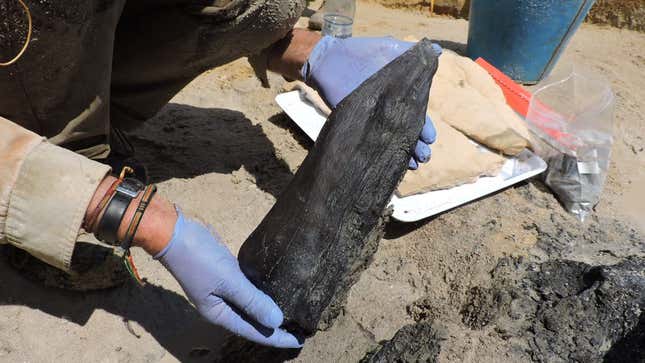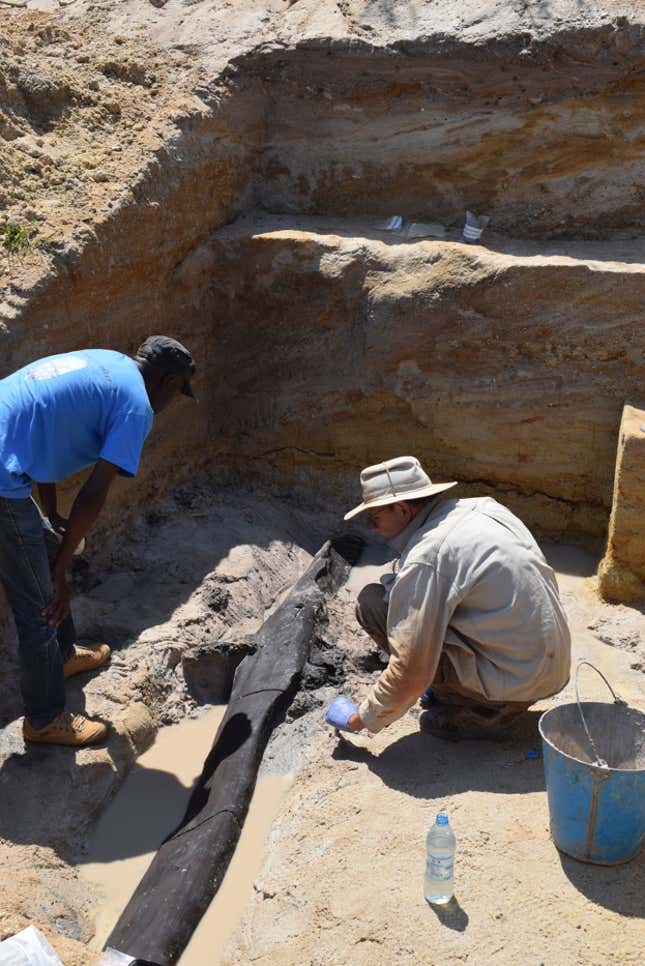
Archaeologists investigating cut logs and other wooden tools at a site near Zambia’s Kalambo Falls have found the settlement to be far more ancient than previously thought: the logs date back to nearly half a million years ago, before our species (Homo sapiens) appeared on Earth.
Though some tools are less than 400,000 years old, the oldest part of the site—comprising two logs, joined at an angle with a cut notch—date to 476,000 years ago, give or take 23,000 years. The four wooden tools found at the site are a notched branch, a cut log, a digging stick, and a wedge, according to the team; the description of the finds was published today in Nature.
“Forget the label ‘Stone Age,’ look at what these people were doing: they made something new, and large, from wood,” said Larry Barham, an archaeologist at the University of Liverpool and lead author of the study, in a university release. “They used their intelligence, imagination, and skills to create something they’d never seen before, something that had never previously existed.”
The oldest known Homo sapiens fossils date to about 300,000 years ago, comfortably more recent than the superlatively old construction at Kalambo Falls, which sits on the eastern end of Lake Tanganyika. The site was excavated over 50 years ago, but the new dating—from luminescence analysis of the deposits containing the wood—reveals the true significance of the site’s age. Wood typically rots away in such ancient sites, but half-million-year-old construction material was waterlogged, preserving it over hundreds of thousands of years.
Though it’s not clear which hominin species did the construction, fossil evidence indicates that Homo heidelbergensis, which is thought to have appeared around 600,000 years ago, lived in the region around the time the structure was built.
The recent team got particularly lucky with the recent site, as wood tends to rot quickly and disappear. This serves as a severe limitation to archaeologists, making it difficult for them to pick out other points in the hominin fossil record and pinpoint when our species and others built structures. One of the oldest-known built structures is a 176,000-year-old wall of stalagmites (that’s right, rock) assembled by Neanderthals (Homo neanderthalensis) in a French cave. The recent team note that the earliest-known modified wood object comes from a site in South Africa that dates to between 100,000 and 200,000 years old. But both of those finds are a far cry from 476,000 years old, but the fact that the latter exists makes it plausible that there was construction in the intervening millennia. Archaeologists just haven’t been fortunate enough—or lacked the technology—to find it.
“These new dating methods have far reaching implications – allowing us to date much further back in time, to piece together sites that give us a glimpse into human evolution,” said Geoff Duller, an archaeologist at Aberystwyth University and co-author of the research, in the same release. “The site at Kalambo Falls had been excavated back in the 1960s when similar pieces of wood were recovered, but they were unable to date them, so the true significance of the site was unclear until now.”

Though some questions are outstanding, including which hominins put it together or used the wooden tools left at the site about 100,000 years later, the researchers have a few ideas of what the construction was supposed to be. The interlocking logs may have formed a structure’s foundation, a walkway, or a raised platform in a region that was periodically covered in water.
“Although Barham and colleagues are rightly cautious about the function of the interconnected logs, they propose a few possibilities to consider, including a walkway, a raised platform or a habitation structure,” wrote Annemieke Milks, an archaeologist at the University of Reading, in an accompanying News & Views article. “Whatever the purpose of such a structure, in what would have been a wet environment, the Kalambo Falls hominins seem to have altered their inhabited space in fundamental ways.”
Besides changing their environment—which indicates the group that lived there were not nomadic, since they bothered to create such durable structures on the site—the hominins in the area show that construction goes back farther than previously thought.
The work was conducted as part of the Deep Roots of Humanity project out of the University of Liverpool, which explores the technological changes in south-central Africa that shaped hominin evolution, and that of early humans specifically, between 500,000 and 300,000 years ago. But given the age of the recently discovered construction, the project may want to push their timelines back.
More: Big Mound on LSU Campus Is the Oldest Known Human-Made Structure in the Americas, Scientists Say